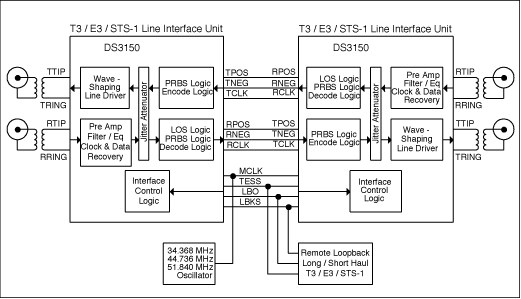

T3/E3/STS-1 Low Cost Repeater
新品快讯
描述
T3/E3/STS-1 Low Cost Repeater
Abstract: As telecom providers service more customers at higher speeds, they need larger network facilities, which require longer cable runs between systems. Interconnects often use copper cable for its price advantage, but problems arise as distance and data rate increase. Converting to fiber-optic based systems is costly. An alternative is to install repeaters, which are cost-effective and do not require replacing existing equipment. This application note describes a simple, low-cost repeater.
Introduction
Today's telecom providers service more customers at higher speeds than ever before. Larger network facilities require longer cable runs between systems. Since a majority of systems use copper cable for interconnects, problems arise when systems are separated by long distances. Longer copper cable runs can carry lower maximum data rates.
This shortcoming can be solved by either switching to fiber optic systems or installing repeaters on the existing cable interconnects. Conversion to fiber optics offers advantages but it is costly. Adding a repeater to the existing line is a simple, cost-effective solution which does not require replacement of existing equipment.
Design
When designing equipment for telecommunication use, it is good practice to adhere to some of the following guidelines. It is extremely important that the integrity of the interconnected high speed data signals is maintained for error free operation. The space inside a telecommunication facility is limited, so it is important that the equipment occupy no more space than necessary. Equipment that is easy to use and configure will reduce problems caused by user error. This repeater circuit was designed with all the above criteria in mind.
The main component of the repeater is the Dallas Semiconductor DS3150 T3 / E3 / STS-1 Line Interface Unit (LIU). This device performs all the functions necessary for interfacing at the physical layer to DS3, E3, and STS-1 lines. The receiver performs clock and data recovery, signal decoding, and loss-of-signal monitoring. The transmitter performs signal encoding and drives standard-compliant waveforms onto 75 ohm coaxial cable. There is also a built in jitter attenuator that can be mapped into the receive or the transmit path. The remaining components are comprised of a single oscillator, passive devices, and an external or on board 3.3 volt power supply.
The diagram and table below list all of the components necessary to build the repeater circuit card excluding the power supply. The circuit is straight forward with two DS3150 devices being connected back to back between RPOS/RNEG/RCLK to TPOS/TNEG/TCLK. This allows for easy configuration and reduces the chance for an installation error. The available options are:
- Remote loop back enable/disable
- Operational mode selection T3/E3/STS-1
- Transmission mode selection long haul/short haul
These options are selected by the switches on the card. The configuration option is for the oscillator which can either be one oscillator for single mode operation, or multiple oscillators for dual and triple mode operation. The remaining components are the magnetics for the line interface and the physical connectors for the transmit and receive cables.

Figure 1. T3 / E3 / STS-1 Repeater block diagram.
Table 1. T3 / E3 / STS-1 Repeater Part Listing
| Device | Part Count | Description | Vendor |
| DS3150 | 2 | 3.3 Volt DS3/E3/STS-1 Line Interface Unit | Dallas Semiconductor |
| PE-65968 | 4 | 6 Pin SMT 1:2CT Transformer | Pulse Engineering |
| NTH089AA3-34.2680 | 1 | 34.368 MHz Oscillator 3.3 Volt | Saronix |
| NTH089AA3-44.7360 | 44.736 MHz Oscillator 3.3 Volt | Saronix | |
| NTH089AA3-51.8400 | 51.840 MHz Oscillator 3.3 Volt | Saronix | |
| BNC Plug | 4 | Various | |
| DIP Switch | 1 | Various | |
| Power Connector | 1 | Various | |
| Resistor | Various | ||
| Capacitor | Various | ||
| LED | 3 | Power & LOS Indication | Various |
- 相关推荐
- 热点推荐
- Repeater
-
HFTA-09.0: T3/E3/STS-1光纤扩展2023-06-10 1541
-
HFTA-09.0: T3/E3/STS-1 光纤扩展2023-03-03 1598
-
T3和E3网络接口布局指南2023-02-22 3185
-
T3/E3/STS-1 LIU二次浪涌保护设计2023-02-13 1812
-
T3/E3/STS-1光纤扩展知识点总结的太棒了2021-05-31 2087
-
DS3 / E3 / STS成帧器设计用于多标准网络和传输系统2019-09-03 1808
-
T3(E3)保护电路及解决方案2009-11-20 2180
-
T3/E3/STS-1光纤扩展-T3/E3/STS-1 Fi2009-04-29 1183
-
DS31256 Unchannelized T3/E3/HS2009-04-20 1278
-
DS317x与DS318x T3/E3/STS-1 LIU回2009-04-18 1113
-
DS3150 业内首款单端口T3/E3 LIU,集成了抖动衰2008-09-19 1665
全部0条评论

快来发表一下你的评论吧 !

